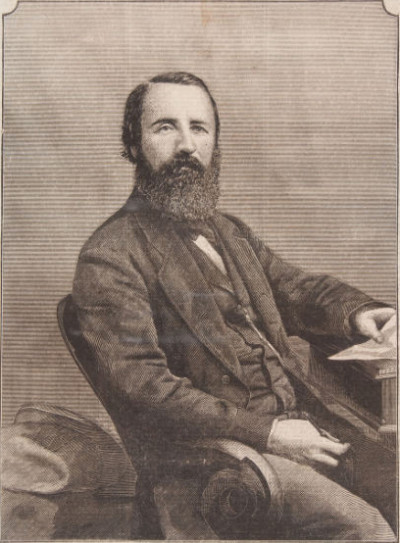Henry Chadwick (Henry Chadwick)

Henry Chadwick was one of the prime movers in the rise of baseball to its popularity at the turn of the 20th century. A keen amateur statistician and professional writer, he helped sculpt the public perception of the game, as well as providing the basis for the records of teams’ and players’ achievements in the form of baseball statistics. He also served on baseball rules committees and influenced the game itself. He is sometimes referred to as “the father of baseball” because he facilitated the popularity of the sport in its early days. Early baseball had a provision known as the “bound rule”, which held that a fielder could catch a batted ball on one bounce and that it would still be recorded as an out. Chadwick was an outspoken critic of the rule for many years, stating that fielders should have to catch a ball on the fly for it to count as an out. In 1864, the bound rule was eliminated for balls hit into fair territory. The bound rule for foul balls persisted into the 1880s. Henry Chadwick edited The Beadle Dime Base-Ball Player, the first annual baseball guide on public sale, as well as the Spalding and Reach annual guides for a number of years and in this capacity promoted the game and influenced the infant discipline of sports journalism. In his 1861 Beadle guide, he listed totals of games played, outs, runs, home runs, and strikeouts for hitters on prominent clubs, the first database of its kind. His goal was to provide numerical evidence to prove which players helped a team to win.
In 1867 he accompanied the National Base Ball Club of Washington D.C. on their inaugural national tour, as their official scorer. The next year, Chadwick wrote the first hardcover baseball book, The Game of Base Ball. In 1874 was instrumental in organizing a tour of England which included games of both baseball and cricket. In his role as journalist, he campaigned against the detrimental effects on the game of both alcohol and gambling. Despite a friendship with Albert Spalding, Henry Chadwick was scornful of the attempts to have Abner Doubleday declared the inventor of baseball. “He means well”, said Chadwick, “but he don’t know”. Chadwick later willed his baseball library to Spalding. Author William Cook wrote that “Chadwick was at times a bit self-aggrandizing, but his heart was always deeply rooted in looking after the best interest of the game.” An 1876 Chicago Tribune article attacked Chadwick’s status as the father of baseball, saying in part that Chadwick “has had enough experience to have made himself a man of respect had heaven but given him a head… he proceeded to call himself the ‘”Father of the Game,’ and to assume much on the strength of the title. But he found an unruly child, and one which disinherited him with rapidity and ease.” Cook writes that Henry Chadwick may have been a victim of “Western journalism”, a sensationalized style of writing.
Henry Chadwick is credited with devising the baseball box score (which he adapted from the cricket scorecard) for reporting game events. The first box score appeared in an 1859 issue of the Clipper. It was a grid with nine rows for players and nine columns for innings. The original box scores also created the often puzzling abbreviation for strikeout as “K” – “K” being the last letter of “struck” in “struck out”. Chadwick assigned numbers to each defensive position for scorekeeping purposes, a system that remains in modern baseball scorekeeping. Newspapers had previously tallied runs scored, but Chadwick’s 1859 box score looked similar in structure to modern ones. Baseball researcher Bill James credits Chadwick’s creation of the box score with his interest in the game, but he criticized Chadwick’s omission of the walk from calculation of a player’s batting average: “”What they failed to understand is that actually the batter has as much or a little more to do with when the walk occurs as the pitcher does. They ignored that element of it and that did distort the game for a lot of people.” The box score was popularized in 1925 when Baseball Magazine republished Chadwick’s 1859 Clipper article. Henry Chadwick is credited with devising statistical measures such as batting average and earned run average (ERA). He felt that batting average was the best representation of a batter’s offensive skills. He initially scored walks as errors charged to the pitcher. Walks did not exist in cricket and upon learning about them in baseball, he felt that they did not have anything to do with offensive skill. He later removed walks entirely from baseball statistics. ERA originated not in the goal of measuring a pitcher’s worth but to differentiate between runs caused by batting skill (hits) and lack of fielding skill (errors). He is also noted as believing fielding range to be a superior skill to avoiding errors.
Born
- October, 05, 1824
- United Kingdom
- Exeter, Devon, England
Died
- April, 20, 1908
- USA
- Brooklyn, New York
Cause of Death
- pneumonia and heart failure
Cemetery
- Green-Wood Cemetery
- Brooklyn, New York
- USA



